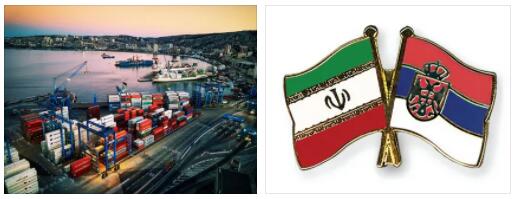Historical legacy
Serbia’s economy is on the path of transformation and modernization. It is still characterized by a double inheritance. On the one hand, from the socialist legacy, a socialist economic structure and economic policy, the transformation of which, due to the Balkan wars, in contrast to the Central and Eastern European countries, began ten years later than 2000. Second, a major economic collapse during the war decade.
Economically, the 1990s were characterized by international isolation and an embargo and the financing of the wars in Croatia, Bosnia-Herzegovina and Kosovo, which by the end of the decade led to a widespread economic collapse. The economic policy of the Milošević regime was largely limited to maintaining political control over the economy, finding sources of finance to finance war and maintaining social peace and preventing social unrest. The formerly publicly owned companies in Yugoslavia were nationalized and the privatization begun by the last all-Yugoslav government was reversed. Foreign and foreign exchange trade were regulated by the state, and prices and wages were largely set administratively. The state-owned companies increasingly regressed to social institutions, which either produced at a loss or whose production collapsed completely. An attempt was made to siphon off private capital / private foreign currency with alternating methods – by freezing the foreign currency checking accounts of the citizens, private banks which gave out horrific interest rates according to the snowball system, a system of parallel currency exchange rates and exchange offices. Smuggling activities organized by the regime and offshore companies complemented efforts to plug holes in the collapsing (war) budget. The result was rising inflation and the use of the printing press, which at the end of 1993 led to the third largest hyperinflation in human history. By the end of the decade, the Serbian economy had fallen well below what it was before the collapse of socialist Yugoslavia. 80% of the banking sector were insolvent, the trust of the citizens in their own currency and the banks disappeared. At the same time, it had largely lost its regional and international markets.
Foreign trade, trade balance
Despite rising exports, Serbia suffers from a chronic foreign trade deficit due to the structural weakness of its industry. In 2011, imports worth USD 19.9 billion were compared with exports worth USD 11.8 billion, a deficit of USD 8.0 billion. In 2011 the export-import coverage rate was 58.5%. However, this trade deficit has decreased significantly in recent years; in 2018 there was an import volume of USD 25.9 billion compared to an export volume of USD 19.2 billion, a coverage rate of 74.4%. The most important trading partners are the countries of the EU, to which Serbia supplies 60% of its exports, as well as the member states of the regional trade association CEFTA with 30%, followed by Russia. The main export countries in 2018 were Italy (12.3% of all exports), Germany (11.9%) and Bosnia-Herzegovina (7.9%). The main importing countries were Germany (13.4% of all imports) Italy (9.4%) and the People’s Republic of China (8.4%) as well as Russia (7.9%). In 2003, Germany established an Economic Cooperation Council with Serbia, which serves as a platform for dialogue between governments and companies. He focuses on the core areas of banking / finance, energy, logistics, water supply, agriculture and tourism. The main export products are iron, steel and non-ferrous metals, wheat, fruits and vegetables and textile products; The main import products are oil and gas, non-ferrous metals, iron and steel,
According to thesciencetutor, Serbia’s trade relations with Russia have moved into the focus of public interest due to the Ukraine crisis and the maneuvering of the Belgrade government between EU integration orientation and traditional relations with the Russian Federation. Despite an existing free trade agreement between the two countries, Serbia’s trade with its Eastern European partner is far behind that with the EU and neighboring countries. As a result of the mutual sanctions between the EU and Russia, the Serbian government was forced to insure under pressure from Brussels that it would not intensify its agricultural exports to Russia and thus undermine Russia’s agricultural sanctions against products from the EU. Serbia suffered a serious setback in connection with the Russian pipeline project Southstream, in the preparation of which Serbia and 7 EU countries participated. This pipeline operated by Gazprom was supposed to transport gas from Russia through the Black Sea via Bulgaria and Serbia to Central Europe, and thus bypassing Ukraine. However, the corresponding contracts between Gazprom and the partner countries violate EU law, so that the European Commission instructed the Bulgarian government in autumn 2014 to temporarily stop the construction that had started. At the beginning of December, Russian President Putin surprisingly announced that Moscow would withdraw from the pipeline project. The Serbian government described the decision to discontinue Southstream as a severe economic blow to the Balkans. Belgrade had hoped for billions in investments and a boost for the country’s economy from the project. However, economists questioned the economic benefit due to Gazprom’s special privileges in the investment project.
German-Serbian economic relations
Germany has been one of Serbia’s most important trading partners for years. With a trade volume of around 4.7 billion euros, Germany ranked first among bilateral trading partners in 2018. The Federal Republic was in first place of the main supplier countries of Serbia with a share of the total imports of 13.4%. The main import products from Germany are machines, vehicles and parts, electrical engineering and plastics. Among the main buyer countries for Serbian products, Germany was in second place behind Italy in 2018 with a share of all exports of 11.9%. Several hundred German companies are registered in Serbia; there is also a significant number of Serbian subsidiaries.
